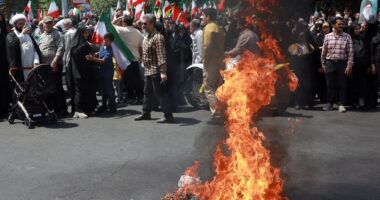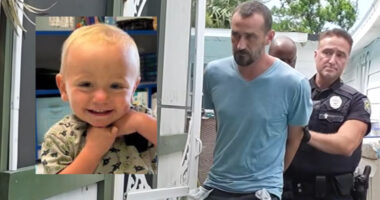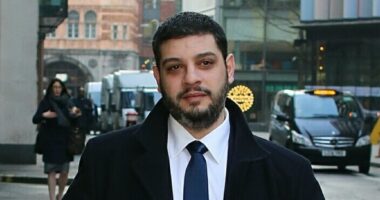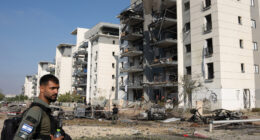GROWING up in the most nuked place on Earth, Maira Abenova has helplessly watched as cancer spread through her family.
After years of living near the Semipalatinsk Test Site, she told The Sun how the devastating impact of the radiation “did not spare any family“.





Known as the Polygon, the 7,000 square mile nuclear testing site in north east Kazakhstan was nuked by hellish bombs from 1949 to 1989.
Having been struck by a quarter of all nuclear explosions in history, the Semipalatinsk Test Site served as an atomic testing ground for Soviet scientists and was shrouded in secrecy for many years.
Its infamous “Atomic Lake” was blasted into existence 60 years ago by a bomb ten times more powerful than the one dropped on Hiroshima.
One of the most devastating detonations at the site allegedly resulted in four times more cases of severe radiation poisoning than the infamous Chernobyl disaster.
Following 40 years of nuclear explosions which wreaked havoc on nearby communities, the consequences are still felt today.
To aid in identifying victims of the aftermath, Kazakh authorities distributed unsettling “radiation passports,” yet these documents have proven inadequate in addressing the full extent of the tragic consequences.
Local resident Maira Abenova told The Sun: “After more than 30 years have passed, we can now say that for 40 years, an atomic war was waged on our beautiful land.”
Now a mum and grandma, Maira was raised in the neighbouring high-risk town of Semipalatinsk, which is by the Russian border and is today known as Semey.
She is also the founder an advocacy group for victims of the tests called Committee Polygon 21.
Maira detailed the tragic consequences of Semipalatinsk Test Site which have scarred her own life.
“In 1971, before turning 60, my mother died of esophageal cancer,” she said.
“At that time, we could not know the cause of this disease.”
After losing her mum, her sister passed away in 2013, nearly 25 years after the last recorded nuclear test.
“In 2013, literally a month after surgery, my older sister passed away from breast cancer,” Maira explained.
Her husband was the next loved one to die as a result of the radioactive fallout.
She said: “My husband was diagnosed with stomach cancer – he lived in agony for only a year and a half before he passed away.”
Maira continued: “Just a few months after my husband’s funeral, my brother was diagnosed with lung cancer.
“He survived only three months.”
The devastating consequences of Semipalatinsk Test Site then caught up with Maira herself.
“Last autumn, I was diagnosed with the same disease,” she said.
“I had an operation, but I don’t know how much time I have left.
“Our medical system offers little hope – not because we lack good doctors, but because the healthcare system, especially in our region, is in a deeply deplorable state.”




She added: “The worst thing is when doctors diagnose cancer. It’s like a death sentence.
“A sentence of a painful death. Without proper help and treatment.”
Maira also noted that her local cancer clinic was “always overcrowded”.
Kazakhstan authorities estimate 1.5 million people have been exposed to the test site’s residual fallout.
Nearby populations suffered elevated rates of cancer, heart disease and infertility which were all linked to the tests.
More babies were born with defects, missing limbs, Down syndrome and other disabilities – while the number of suicide rates among young people also rose.
A local city hall official even made the shocking claim that “people in the villages got used to suicides”, according to a UN report.
And grandma-of-two Maira confirmed this epidemic, saying that after the closure of the site, the higher rates of suicide were known as “Kainarsky syndrome”.
Despite the first ever bomb going off on August 29, 1949, four years after the end of World War II, radiation levels are still elevated, and children continue to be born with genetic mutations.
Maira said: “This evil did not spare any family.”
Reflecting on these haunting health impacts, she described the aspect that continues to trouble her most.
“As for the photos showing the aftermath of the tests, I’d say the most frightening consequences aren’t the physical deformities or developmental anomalies,” she said.
“But rather the lingering fear — the fear of dying from an illness that might not be visible on the outside.
“The fear of a young woman giving birth to a child with disabilities, and so on.”



The campaigner also detailed a closed-off town called Kurchatov which was built as the headquarters for the testing site and was only accessible with an official pass.
Codenamed Semipalatinsk 21, the base was full of nuclear scientists and military officers, and located on the picturesque bank of the Irtysh River.
The top-secret town had 50,000 or so inhabitants who were all supplied with high quality produce sent straight from the capital.
Meanwhile, locals outside the town lived in relative squalor with “empty store shelves”, Maira explained.
“It was built in a short time,” she said of the city, which has been dubbed the Soviet version of Los Alamos.
“Since the city was built by the military, it resembles a military town – strict lines and no frills.”
The activist added that scientists timed each blast to match the wind direction – making sure the deadly fallout always blew away from their own HQ.
And typical Soviet cover-ups meant that even the locals were unaware of the nearby tests for years.
“We didn’t know about it until the late 1980s, when information about the terrible tests conducted near us began to leak out to the public,” she recalled.
Semipalatinsk’s role in the Cold War

by Harvey Geh
Semipalatinsk Test Site, also known as the Polygon, played a central role in the Soviet Union’s push to win the nuclear arms race during the Cold War.
On August 29, 1949, the USSR detonated its first-ever atomic bomb at Semipalatinsk, just four years after the U.S. bombed Hiroshima and Nagasaki.
That explosion – codenamed RDS-1 or “First Lightning” – ended America’s nuclear monopoly and officially launched the Cold War arms race.
It was a near-copy of the US-made “Fat Man” plutonium bomb, which America dropped on Nagasaki, Japan in August 1945.
Following the landmark explosion, Semipalatinsk became the main site for testing each nuclear development the Soviet Union made, including hydrogen bombs and experimental warheads.
This allowed the USSR to gain data on blast yields and radiation fallout.
From its inception in 1949 to its closure in 1989 with the fall of the Berlin Wall, 116 bombs were detonated in the atmosphere, while 240 exploded underground.
A law created in 1992 meant victims could apply for a “radiation passport”, which confirmed their exposure to the fallout and qualified them for certain benefits.
Each person who had their application approved was given a little beige book with a big blue mushroom cloud on its front cover.
Those holding their own document could then receive things like monthly compensation cash and longer holidays.
This system was said to have worked in its initial phases.
But these days, the scheme is ineffective, according to Maira.
She is now part of a renewed push to improve compensation and bring real justice to the lives of many who have been impacted.
Maira said: “The law that was passed in 1992 is effectively defunct today, and its current provisions are discriminatory.”


The passport grants holders £30 per month in benefits – barely enough to cover current medical costs – and those who move to live in a different region are disqualified from getting the money.
Many locals have reportedly found it challenging to get official recognition for their children to also obtain the document.
Emphasising the importance of petitioning for better support, Maira explained: “The hardest thing for us is that we feel doomed and unprotected.”
Maira also heads the human rights organisation DOM, which has also played an important role forming initiatives aimed at protecting the rights of victims of nuclear tests.
She says on social media that for the last three years, the organisation has been working “to shape new ways of addressing victims, to achieve significant change, and to expand dialogue with the state and the international community.”
Maira has won awards for her work supporting victims of the tests and participated in UN meetings calling for the ban of nuclear weapons.
She left Committee Polygon 21 earlier this month but continues to work with victims of nuclear fallout through her leading role at DOM.
It is believed that more than one million people resided in and around Semipalatinsk – but today, only a few thousand people remain.
The International Day against Nuclear Tests occurs every year on August 29, the day the first bomb went off in Semipalatinsk Test Site.
Despite neighbouring locals living through the nuclear fallout of the site, it remains unclear exactly how dangerous living in the region is today.
Scavengers have excavated the site in hopes of selling off scrap metal, while locals are known to use the “Atomic Lake” as a fishing spot.
Maira said she was aware locals like to go fishing there as they “have come to believe that it is safe”.
But since the landscape has been marred by nearly half a century of nuclear bombing, she said the area had partly lost its beauty.
“It is more reminiscent of the surface of the moon,” she said.
“A steppe and granite hills that have crumbled over time… scattered across by the atomic explosions.”

















